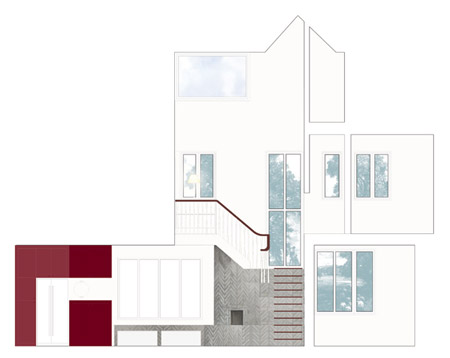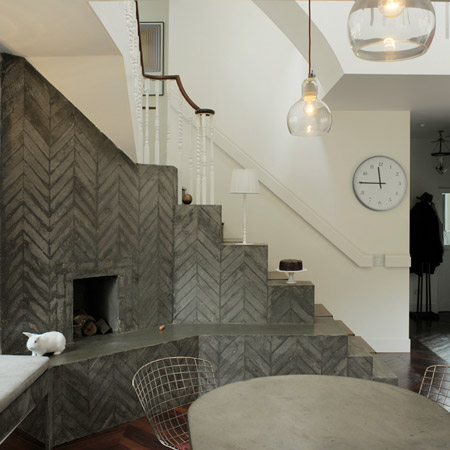
Hearth House by AOC
London architects AOC have remodelled the interior of an Edwardian suburban home at Golders Green, London, which includes a concrete hearth with a parquet pattern.
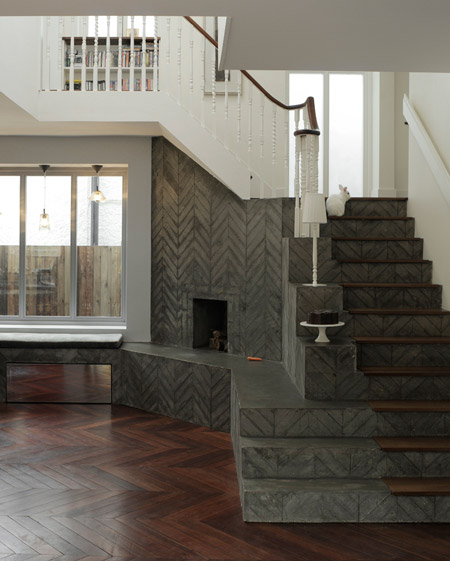
The semi-detached house also features details such as a staircase with a negative plywood balustrade design, lamps protruding from handrails on banisters and picture frames forming the handles of cupboards.
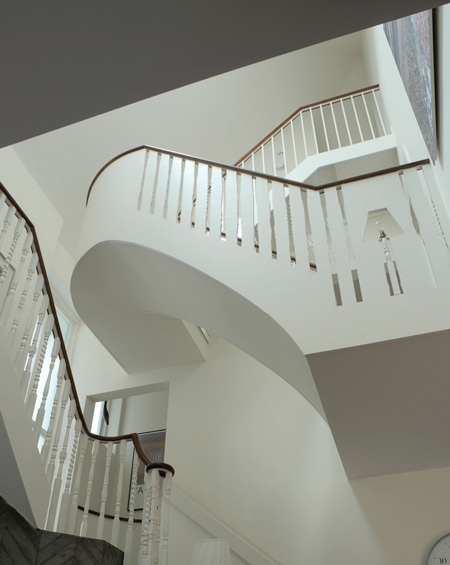
The architects have been able to increase the useable floor area of the house by 20 percent and increase the amount of natural light reaching the previously dark, north-facing rooms by installing a large rooflight.
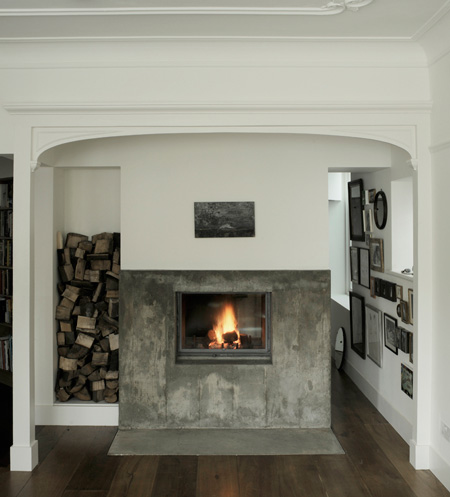
Here are more details from AOC:
AOC have completed the Hearth House, a new family home in north London.
Located in the suburb of Golders Green the home is an extensive redevelopment of an Edwardian semi-detached house. Working within the existing building footprint the architects have increased the useable floor area by 20% and dramatically re-ordered the internal rooms to provide a range of different spaces to meet the evolving needs of a couple and their three teenage sons.
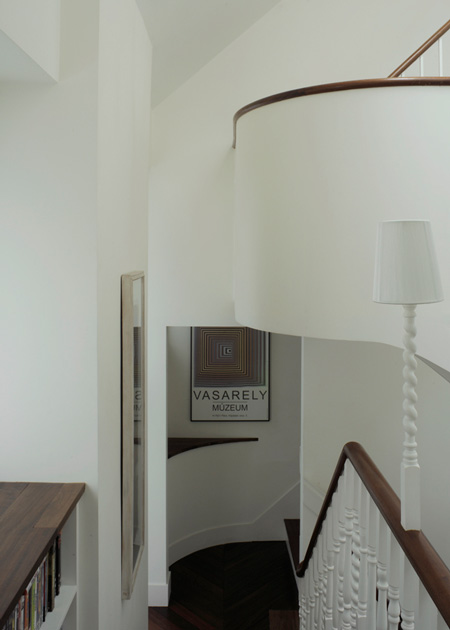
The house has been opened up with a triple height space to bring light into the previously dark north facing rooms. At the bottom of this space sits a heated poured concrete hearth and stair providing a relaxed centre for family life.
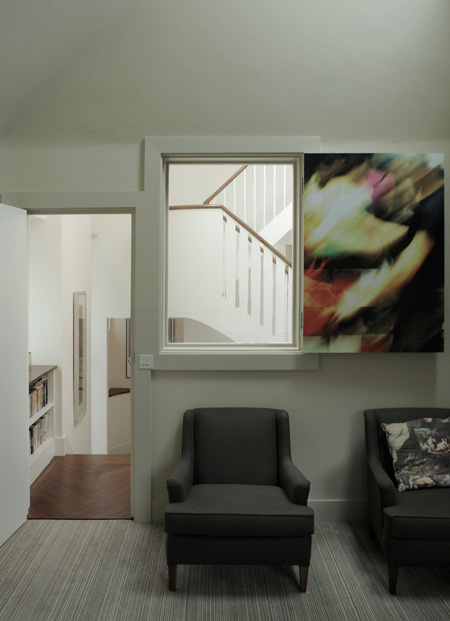
"There are few homes more apparently normal than the suburban semi-detached," says architect Geoff Shearcroft of AOC. "Yet their spatial generosity and simple construction make them extremely adaptable and capable of accommodating a fantastically diverse range of living arrangements. The Hearth House provides one example of how these ubiquitous houses can be fine tuned to meet the specific needs of a contemporary family."
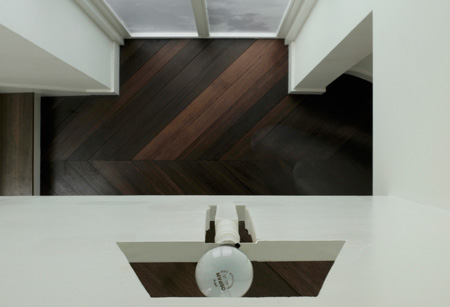
ARCHITECT'S DESCRIPTION OF THE SCHEME
The Hearth House is a redeveloped Edwardian semi-detached house in North London that provides a new home for a family of five. Untouched since the 1940s the old house enjoyed a generous provision of space but was dark, spatially unvaried and saturated in the residue of the previous residents.
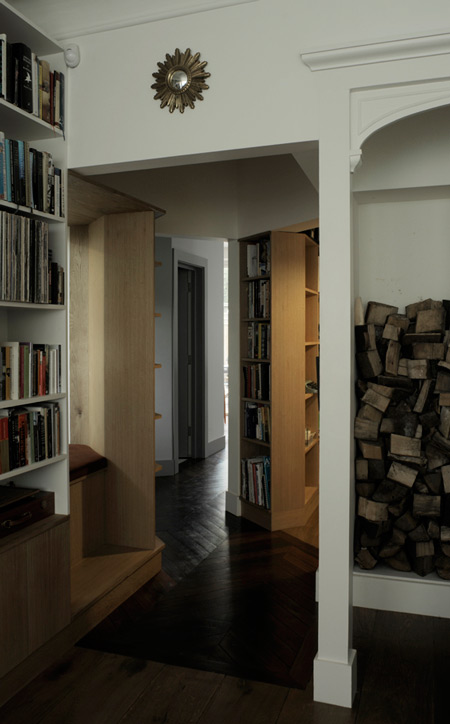
The client wanted to create a home that was tuned to the specific needs of the family, allowing the potentially separate lives of a couple and three teenage boys to coexist concurrently and beneficially. Having previously developed two homes the client knew exactly how she wanted to use the house but felt frustrated by traditional room descriptions. A careful consideration of the use of their old home allowed use and inhabitation to become the focus of the design.
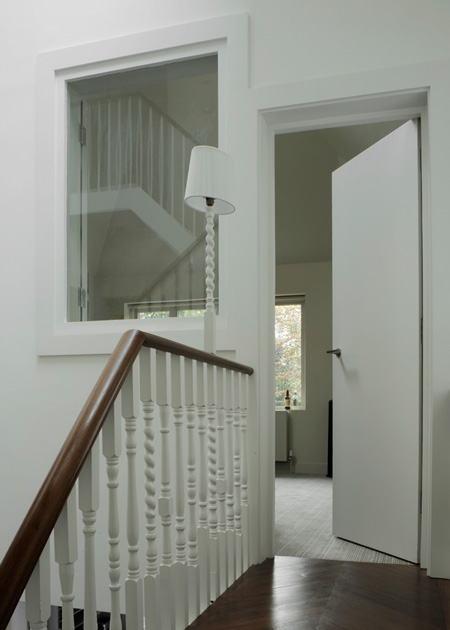
The original brief, described through conversation, was developed into a drawn ‘spatial constitution’. This was the first stage in developing a shared language between the family and their architects and provided a stepping stone between the loose complexity of their evolving needs and the certainty of a three dimensional proposal.
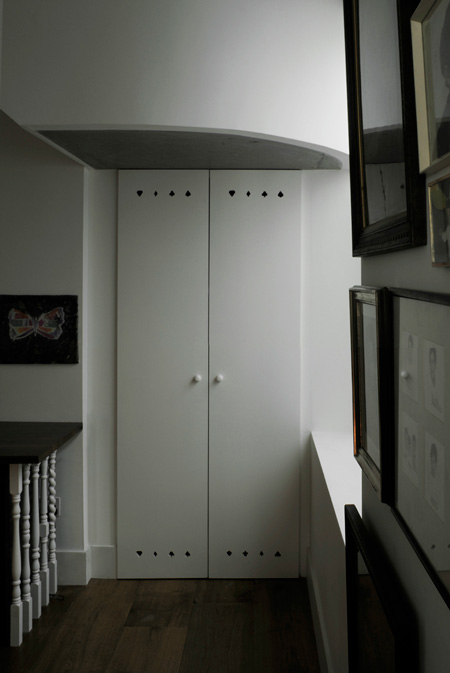
Externally the house remains familiar yet has a significantly different character. Existing openings are retained but all the doors and windows have been replaced with black stained timber frames and single panes. This shifts the scale to that of a larger dwelling, increases the perceived weightiness of the facade and increases the daylight into the home.
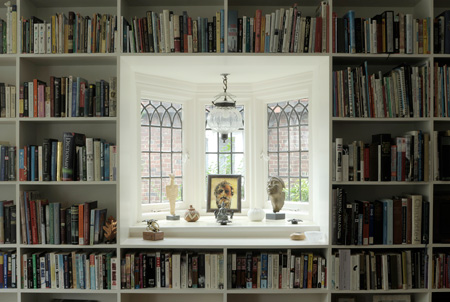
The completed home has a diverse range of internal spaces, whose individual characters are defined by an assortment of architectural effects. The ground floor is a series of open sided rooms, visually connected by long glimpses yet distinct enough to allow different activities to go on at the same time in close proximity; dinner parties alongside guitar practice, homework by surround-sound football matches.
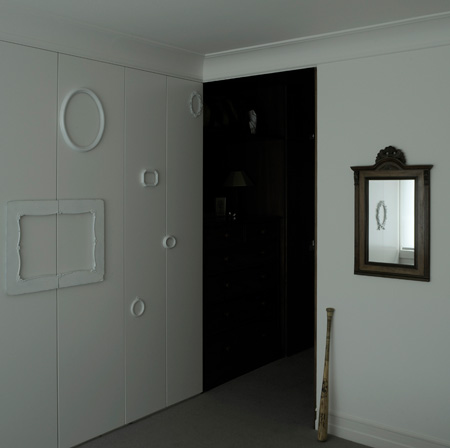
Upstairs the rooms follow a more traditional cellular form allowing every family member to retreat to their own space. Nooks, internal windows, screens and openings ensure the family can easily enjoy the more public areas of the house whilst maintaining their own desired level of privacy.
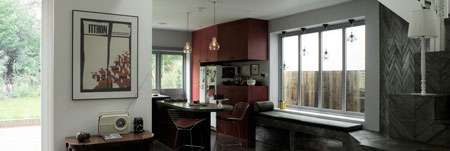
Click for larger image
A triple height space, lit from above by an openable rooflight, brings direct sunlight into the heart of the north facing home. At its base a warm poured concrete hearth and stair provide a relaxed centre for family life, perfect for clambering and reclining. The pattern of the reclaimed chevron parquet flooring is repeated in the surface of the concrete, encouraging domestic and historical associations for an unfamiliar material and object.
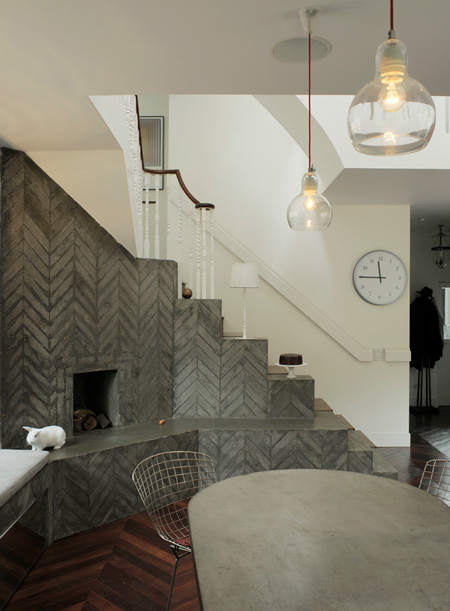
The new stair uses an assortment of appropriate styles to meet both functional needs and aspirational needs; a Victorian moulded timber balustrade provides a grand ascent to a landing that divides in two; a laser-cut ply negative provides a similarly familiar but more enclosed escape to the bedrooms; and a Modern open tread steel stair to the attic maximises the daylight from above and enhances the feeling of lightness.
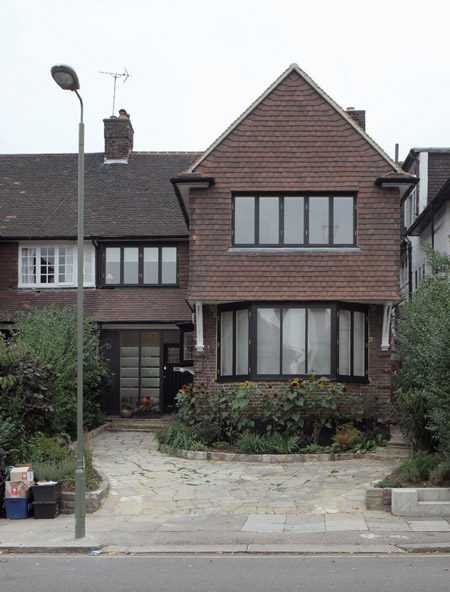
Elsewhere in the home traditional domestic elements are re-appropriated for similar effect; stair balustrades support a desk, picture frames create wardrobe handles and a skirting board becomes a handrail. The collage of new and sampled elements have been synthesised together with the existing fabric through a universal coat of warm off-white paint, imparting the home with an instant maturity.
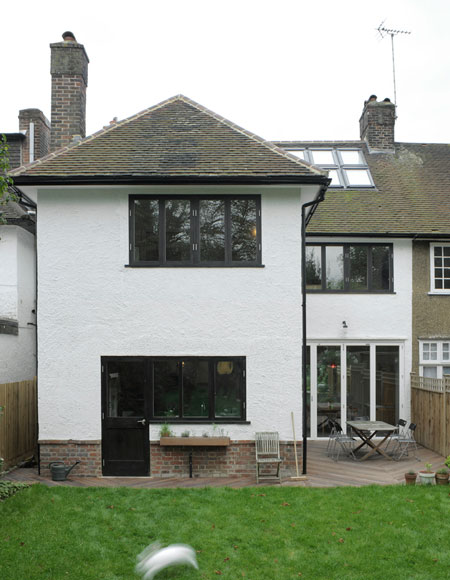
ABOUT THE PRACTICE
AOC is a practice of architects, urbanists and interpreters, established in 2003 by Tom Coward, Daisy Froud, Vincent Lacovara and Geoff Shearcroft. Building on experience gained at respected practices and regeneration bodies in London and abroad, our architecture is both robustly pragmatic and beautifully imaginative. We embrace challenging projects and encourage clients to be demanding, generating open, honest, generous proposals in response.

Early projects, including the New Centre for Architecture in London, a rural retreat for Stephen Daldry and a ‘house to stimulate different modes of thinking’ for Alain de Botton, and a series of successful competition wins brought AOC to the attention of a wide range of clients and received international attention.

Realised projects include the Janet Summers’ Early Years Centre, Southwark; the redevelopment of the Royal Armouries Museum, Leeds; the consultative process, design and realisation of the Lift, a demountable performance space for the London International Festival of Theatre; No.1 Lower Carbon Drive, a touring exhibition for the London Development Agency; a number of private residences; and an urban regeneration game for Building Futures/ RIBA and CABE.
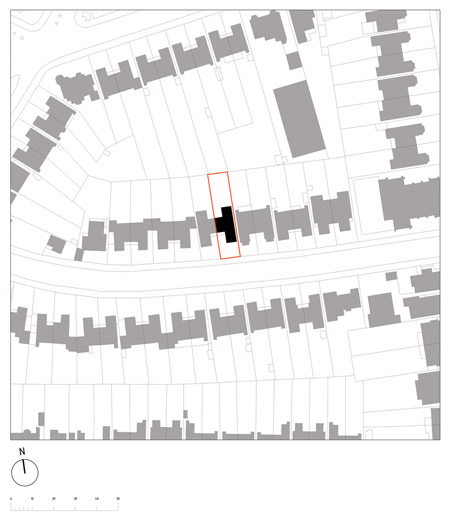
Current work includes a new school for pupils with autism; the ongoing development of both Friars Primary and Charles Dickens Primary School; two first-placed housing schemes in the Elephant and Castle regeneration project; a new home for child clients for an exhibition in Stockholm; and a winning master-design for 400 homes in South London.

Winners in the AJ/Corus ‘40 under 40’ and runners up in the Young Architect of the Year 2008, we exhibited at the Venice Biennale 2008. Our work has been internationally published and exhibited in leading museums and galleries in the UK, Europe and USA. We have taught at many leading schools of architecture and are the Louis I. Kahn Visiting Assistant Professors at Yale for 2011. We regularly lecture in the UK and Europe and contribute to contemporary architectural culture through television, radio and public debate.

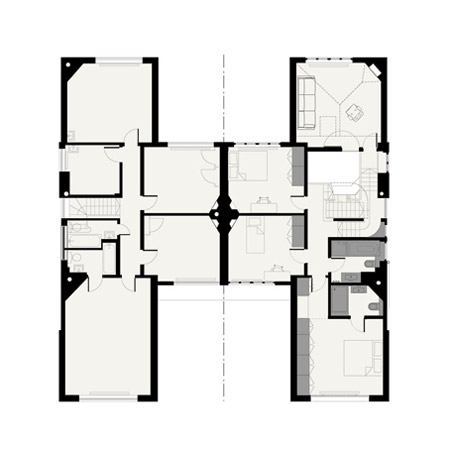
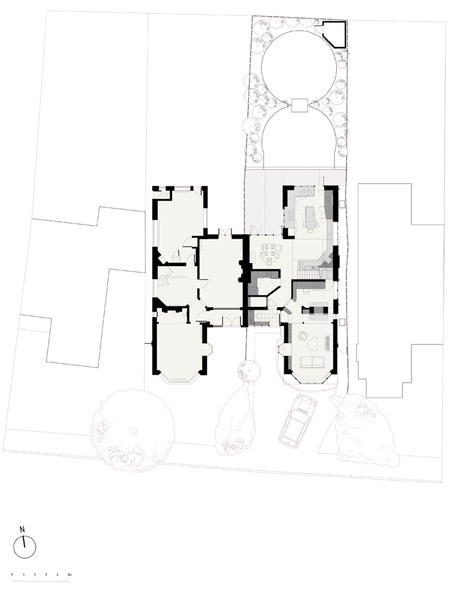
Click for larger image
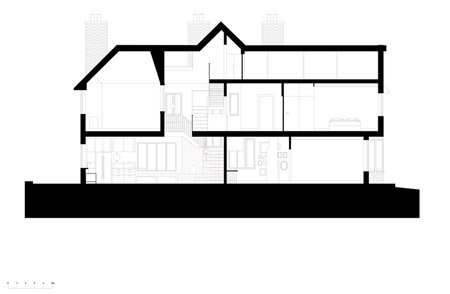
Click for larger image
